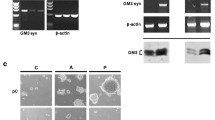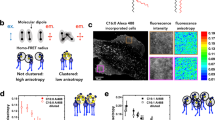Abstract
At cell surface gangliosides might associate with signal transducers proteins, grown factor receptors, integrins, small G-proteins and tetraspanins establishing microdomains, which play important role in cell adhesion, cell activation, motility, and growth. Previously, we reported that GM2 and GM3 form a heterodimer that interacts with the tetraspanin CD82, controlling epithelial cell mobility by inhibiting integrin-hepatocyte growth factor-induced cMet tyrosine kinase signaling. By using molecular dynamics simulations to study the molecular basis of GM2/GM3 interaction we demonstrate, here, that intracellular levels of Ca2+ mediate GM2/GM3 complexation via electrostatic interaction with their carboxyl groups, while hydrogen bonds between the ceramide groups likely aid stabilizing the complex. The presence of GM2/GM3 complex alters localization of CD82 on cell surface and therefore downstream signalization. These data contribute for the knowledge of how glycosylation may control signal transduction and phenotypic changes.
Graphical abstract






Similar content being viewed by others
Data availability
All data generated or analyzed during this study are included in this published article [and its supplementary information files].
References
Hakomori, S.: Traveling for the glycosphingolipid path. Glycoconj J 17(7–9), 627–647 (2000)
Todeschini, A.R., Hakomori S.I.: Functional role of glycosphingolipids and gangliosides in control of cell adhesion, motility, and growth, through glycosynaptic microdomains. Biochim. Biophys. Acta. 1780(3), 421–33 (2008)
Rock, P., et al.: Organization of glycosphingolipids in phosphatidylcholine bilayers: use of antibody molecules and Fab fragments as morphologic markers. Biochemistry 29(36), 8484–8490 (1990)
Matuoka, S., et al.: Phase behavior in multilamellar vesicles of DPPC containing ganglioside GM3 with a C18:1 sphingoid base and a 24:0 acyl chain (GM3(18,24)) observed by X-ray diffraction. Chem Phys Lipids 123(1), 19–29 (2003)
Matsubara, T., et al.: Heterogeneous Ganglioside-Enriched Nanoclusters with Different Densities in Membrane Rafts Detected by a Peptidyl Molecular Probe. Langmuir 37(2), 646–654 (2021)
Suzuki, K.G.N., et al.: Development of new ganglioside probes and unraveling of raft domain structure by single-molecule imaging. Biochim Biophys Acta Gen Subj 1861(10), 2494–2506 (2017)
Grauby-Heywang, C., Turlet, J.M.: Behavior of GM3 ganglioside in lipid monolayers mimicking rafts or fluid phase in membranes. Chem Phys Lipids 139(1), 68–76 (2006)
Nores, G.A., et al.: Density-dependent recognition of cell surface GM3 by a certain anti-melanoma antibody, and GM3 lactone as a possible immunogen: requirements for tumor-associated antigen and immunogen. J Immunol 139(9), 3171–3176 (1987)
Kaida, K., et al.: Anti-ganglioside complex antibodies associated with severe disability in GBS. J Neuroimmunol 182(1–2), 212–218 (2007)
Kaida, K., et al.: Ganglioside complexes as new target antigens in Guillain-Barre syndrome. Ann Neurol 56(4), 567–571 (2004)
Hakomori, S., Handa, K.: Glycosphingolipid-dependent cross-talk between glycosynapses interfacing tumor cells with their host cells: essential basis to define tumor malignancy. FEBS Lett 531(1), 88–92 (2002)
Todeschini, A.R., et al.: Ganglioside GM2-tetraspanin CD82 complex inhibits met and its cross-talk with integrins, providing a basis for control of cell motility through glycosynapse. J Biol Chem 282(11), 8123–8133 (2007)
Todeschini, A.R., et al.: Ganglioside GM2/GM3 complex affixed on silica nanospheres strongly inhibits cell motility through CD82/cMet-mediated pathway. Proc Natl Acad Sci U S A 105(6), 1925–1930 (2008)
Dohi, T., Nores, G., Hakomori, S.: An IgG3 monoclonal antibody established after immunization with GM3 lactone: immunochemical specificity and inhibition of melanoma cell growth in vitro and in vivo. Cancer Res 48(20), 5680–5685 (1988)
Lee, L., Abe, A., Shayman, J.A.: Improved inhibitors of glucosylceramide synthase. J Biol Chem 274(21), 14662–14669 (1999)
Sandro Sonnino, M.N., Chigorno V.: Preparation of radiolabeled gangliosides. Glycobiology 6(5), 479–187 (1996)
Hockney, R.W.: The potential calculation and some applications. Methods Comput Phys 9, 136–211 (1970)
Essmann, U., et al.: A Smooth Particle Mesh Ewald Method. J. Chem. Phys. 103(19), 8577–8593 (1995)
Ryckaert, J.P., Ciccotti, G., Berendsen, H.J.C.: Numerical-Integration of Cartesian Equations of Motion of a System with Constraints - Molecular-Dynamics of N-Alkanes. J. Comput. Phys. 23(3), 327–341 (1977)
Woods, R.J.: Computational carbohydrate chemistry: what theoretical methods can tell us. Glycoconj. J. 15(3), 209–216 (1998)
Bayly, C.I., et al.: A Well-Behaved Electrostatic Potential Based Method Using Charge Restraints for Deriving Atomic Charges - the Resp Model. J. Phys. Chem. 97(40), 10269–10280 (1993)
Lins, R.D., Hunenberger, P.H.: A new GROMOS force field for hexopyranose-based carbohydrates. J. Comput. Chem. 26(13), 1400–1412 (2005)
Apra, E., et al.: NWChem, a computational chemistry package for parallel computers, version 4.7. Pacific Northwest National Laboratory, Richland, Washington 99352–0999, USA (2005)
Kakizaki, H., Yamaguchi, T., Suzuki, H., Kubota, Y., Ishii, N., Numasawa, K., Suzuki, K.: Tumor factors concerned with primary culture of transitional cell carcinomas. Nihon Hinyokika Gakkai zasshi. Japanese J. Urol. 81(2), 204–209 (1990)
Masters, J.R., Hepburn, P.J., Walker, L., Highman, W.J., Trejdosiewicz, L.K., Povey, S., Franks, L.M.: Tissue culture model of transitional cell carcinoma: characterization of twenty-two human urothelial cell lines. Can. Res. 46(7), 3630–3636 (1986)
Koshy, K.M., Boggs, J.M.: Investigation of the calcium-mediated association between the carbohydrate head groups of galactosylceramide and galactosylceramide I3 sulfate by electrospray ionization mass spectrometry. J Biol Chem 271(7), 3496–3499 (1996)
Yu, S., et al.: Binding of rainbow trout sperm to egg is mediated by strong carbohydrate-to-carbohydrate interaction between (KDN)GM3 (deaminated neuraminyl ganglioside) and Gg3-like epitope. Proc Natl Acad Sci U S A 99(5), 2854–2859 (2002)
Okada, Y., et al.: Glycosphingolipids in detergent-insoluble substrate attachment matrix (DISAM) prepared from substrate attachment material (SAM). Their possible role in regulating cell adhesion. Exp. Cell Res. 155(2), 448–56 (1984)
Santos, J.I., et al.: Assessing carbohydrate-carbohydrate interactions by NMR spectroscopy: the trisaccharide epitope from the marine sponge Microciona prolifera. ChemBioChem 10(3), 511–519 (2009)
Geyer, A., Gege, C., Schmidt, R.R.: Calcium-Dependent Carbohydrate-Carbohydrate Recognition between Lewis(X) Blood Group Antigens This research was supported by the Deutsche Forschungsgemeinschaft and the Fonds der Chemischen Industrie. Angew Chem Int Ed Engl 39(18), 3245–3249 (2000)
Ono, M., et al.: Glycosylation effect on membrane domain (GEM) involved in cell adhesion and motility: a preliminary note on functional alpha3, alpha5-CD82 glycosylation complex in ldlD 14 cells. Biochem Biophys Res Commun 279(3), 744–750 (2000)
Sridhar, S.C., Miranti, C.K.: Tetraspanin KAI1/CD82 suppresses invasion by inhibiting integrin-dependent crosstalk with c-Met receptor and Src kinases. Oncogene 25(16), 2367–2378 (2006)
Lee, J., et al.: The metastasis suppressor CD82/KAI1 inhibits fibronectin adhesion-induced epithelial-to-mesenchymal transition in prostate cancer cells by repressing the associated integrin signaling. Oncotarget 8(1), 1641–1654 (2017)
Park, J.J., et al.: KAI1 suppresses HIF-1alpha and VEGF expression by blocking CDCP1-enhanced Src activation in prostate cancer. BMC Cancer 12, 81 (2012)
Liu, X., et al.: Src/STAT3 signaling pathways are involved in KAI1-induced downregulation of VEGF-C expression in pancreatic cancer. Mol Med Rep 13(6), 4774–4778 (2016)
Dorahy, D.J., Burns, G.F.: Active Lyn protein tyrosine kinase is selectively enriched within membrane microdomains of resting platelets. Biochem J 333(Pt 2), 373–379 (1998)
Fernandez, L., et al.: CD82 and Gangliosides Tune CD81 Membrane Behavior. Int. J. Mol. Sci. 22(16), (2021)
Acknowledgements
This work was supported by funding Coordenação de Aperfeiçoamento de Pessoal de Nível Superior (CAPES, to R.C. Santos, H.F. Loponte), Conselho Nacional de Desenvolvimento Científico e Tecnológico (CNPq, to D.M.S. Lucena, A.R. Todeschini), Fundação de Amparo à Pesquisa do Estado do Rio de Janeiro (FAPERJ, to A.R. Todeschini).
Author information
Authors and Affiliations
Corresponding author
Ethics declarations
Competing interests
The authors have no competing interests to declare that are relevant to the content of this article.
Ethical approval
This article does not contain any studies with human participants or animals performed by any of the authors.
Additional information
Publisher's Note
Springer Nature remains neutral with regard to jurisdictional claims in published maps and institutional affiliations.
Rights and permissions
About this article
Cite this article
Santos, R.C.M., Lucena, D.M.S., Loponte, H.F.B.R. et al. GM2/GM3 controls the organizational status of CD82/Met microdomains: further studies in GM2/GM3 complexation. Glycoconj J 39, 653–661 (2022). https://doi.org/10.1007/s10719-022-10061-z
Received:
Revised:
Accepted:
Published:
Issue Date:
DOI: https://doi.org/10.1007/s10719-022-10061-z




